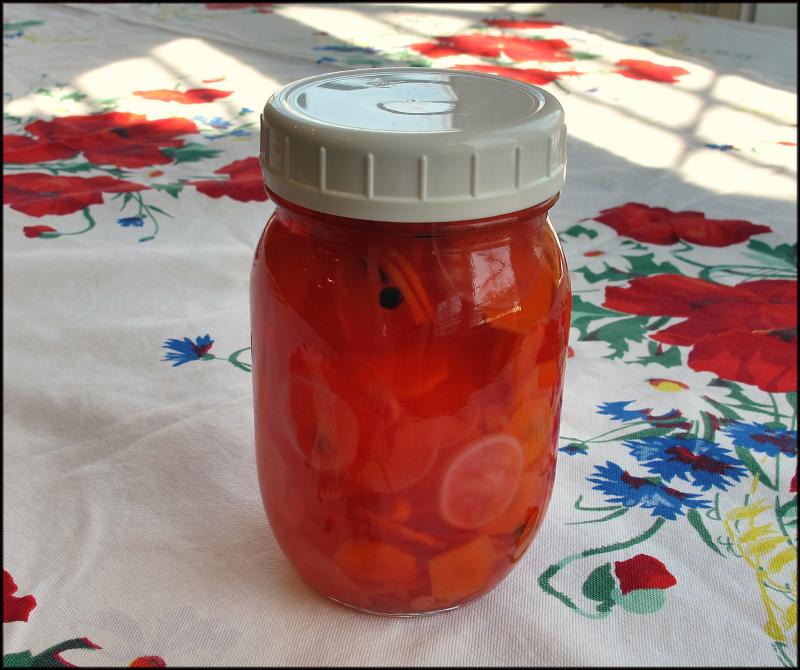Quick pickles offer satisfying taste without the wait
A small bunch of just-picked radishes from Hattie’s Garden was the inspiration for this week’s column. Bright pink, round and smooth, they were the ideal ingredient for a quick pickle. Also known as “refrigerator pickles,” raw or minimally cooked ingredients are covered in a heated brine and refrigerated overnight for the flavors to meld. You can keep them for a few weeks, although ours typically don’t last that long. The difference between a quick pickle and a fermented pickle, like those familiar dill spears, is the process used to prepare them. For the latter, you pack the vegetables in a canning jar and add brining liquid with sufficient salinity to prevent bacteria formation. These are capped with self-sealing lids and processed in a water bath or loosely covered and set aside to ferment. Either version will need to cure for at least a few days before they are properly fermented.
As you may know, fermented foods are considered a rich source of gut-healing probiotics. You can tell the microbes are present when the liquid starts to cloud and tiny bubbles rise to the top. Some people advocate drinking the brine for an additional boost of tangy nutrition.
Although we consider cucumbers the typical target for making pickles, you can use almost any firm, fresh vegetable. Examples include radishes, zucchini, summer squash, carrots and cauliflower. I like to add an allium, such as shallot, onion or garlic for another layer of flavor. As for the spices, that will be an entirely personal choice; consider fennel, mustard, celery, or coriander seeds, peppercorns and allspice. For a strong dill flavor, combine both dill seeds and fresh dill fronds in the mix.
I’ve included the recipe for the radish and carrot quick pickle in the photo, which calls for rice wine vinegar. You could substitute another type of vinegar, but I wanted to keep it light and bright, so I didn’t go with apple cider vinegar. The black dots in the photo are allspice, and you can’t see the grated ginger or cardamom, which dissolved into the brine.
The second recipe is for a traditional dill pickle that uses the natural yeast on the surface of the cucumbers to aid fermentation. As you see in the ingredients list, we aren’t using any vinegar, but allowing the liquid to ferment and form that signature tang. To properly prepare the cucumbers, be sure to cut off the flower end, as bacteria can sometimes hide there.
The instructions refer to “fermentation weights,” which resemble thick glass lids with a handle on top. These are designed to fit snugly inside the mouth of the glass canning jar and keep the ingredients completely submerged in the brine. If you don’t have one, fill a small zip-top bag with water as a weight. Another ingredient that is key to the process is bay leaf, which contributes tannic acid to keep the cucumber skins crisp.
As the pickle jar sits in a cool, dark place like a basement or lower kitchen cupboard for three or four days, make sure to keep it in a bowl to catch any overflow liquid, and loosely drape the jar with a clean kitchen towel to allow air to escape. Once you are satisfied with the fermentation, place the jar in the refrigerator to stop the process.
Now that spring is here, there will be all sorts of wonderful produce to pickle.
Radish & Carrot Quick Pickle
1 bunch radishes
1 carrot
1/3 C thinly sliced onion
1 C water
1 C rice wine vinegar
2 T sugar
1 T salt
1 t grated ginger
3 crushed cardamom pods
1 1/2 t whole allspice
Trim the radishes and thinly slice using a mandoline. Clean and trim the carrots, and thinly slice on the mandoline. Layer the vegetables with the onion in a 2-cup mason jar; set aside. In a small saucepan, combine the remaining ingredients. Bring to a boil, then reduce heat and simmer for about 10 minutes. When the liquid cools slightly, pour into the jar, leaving 1-inch headroom at the top. Cover with self-sealing lid and place in the refrigerator overnight.
Easy Dill Pickles
2 1/2 lbs small pickling cucumbers
5 C water
2 T sea salt
1 t coriander seeds
1 t peppercorns
1 t dill seeds
1 t mustard seeds
8 sliced garlic cloves
2 sliced shallots
3 or 4 sprigs of fresh dill
3 or 4 bay leaves
Clean and sterilize two quart-size glass jars; set aside. Rinse the cucumbers, trim off the flower ends. Place them in an ice/water bath in a bowl for 10 minutes. In a large mixing bowl, whisk together water and salt until dissolved; set aside. Divide the coriander, peppercorn, dill and mustard seeds between the two jars. Pack in one layer of cucumbers on their ends, and divide the garlic and shallots between the jars. Add dill and bay leaves. If there’s room, add another layer of cucumbers standing on end. Tamp down the ingredients and pour in brine to cover, leaving one inch of headroom at the top of the jars. Use a fermentation weight or water-filled zip-top bag to keep the contents submerged, making sure that air can still escape. Place the jars in a bowl and cover loosely with a clean kitchen towel. Place the jars in a cool, dark place and allow to ferment for at least 3 to 4 days. Check for bubbles and clouding, which signal the fermentation process was successful. Move the jars to the refrigerator and sample contents once they’re chilled.
Send comments, questions and recipe suggestions to capeflavors@comcast.net.






















































